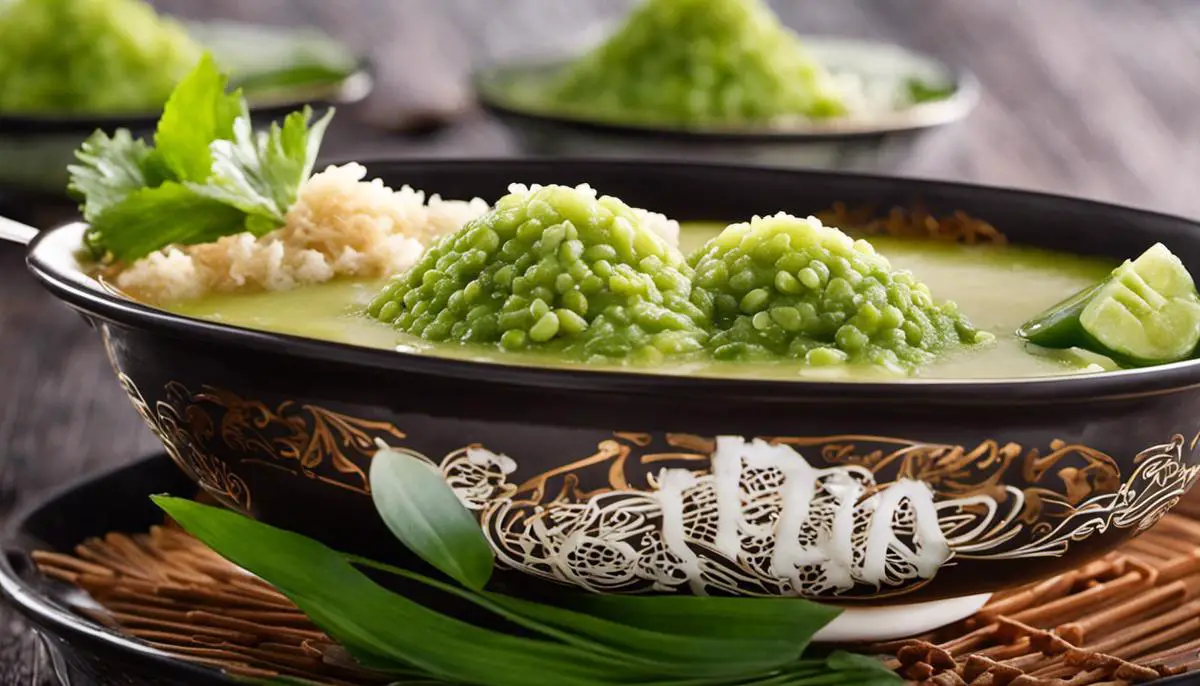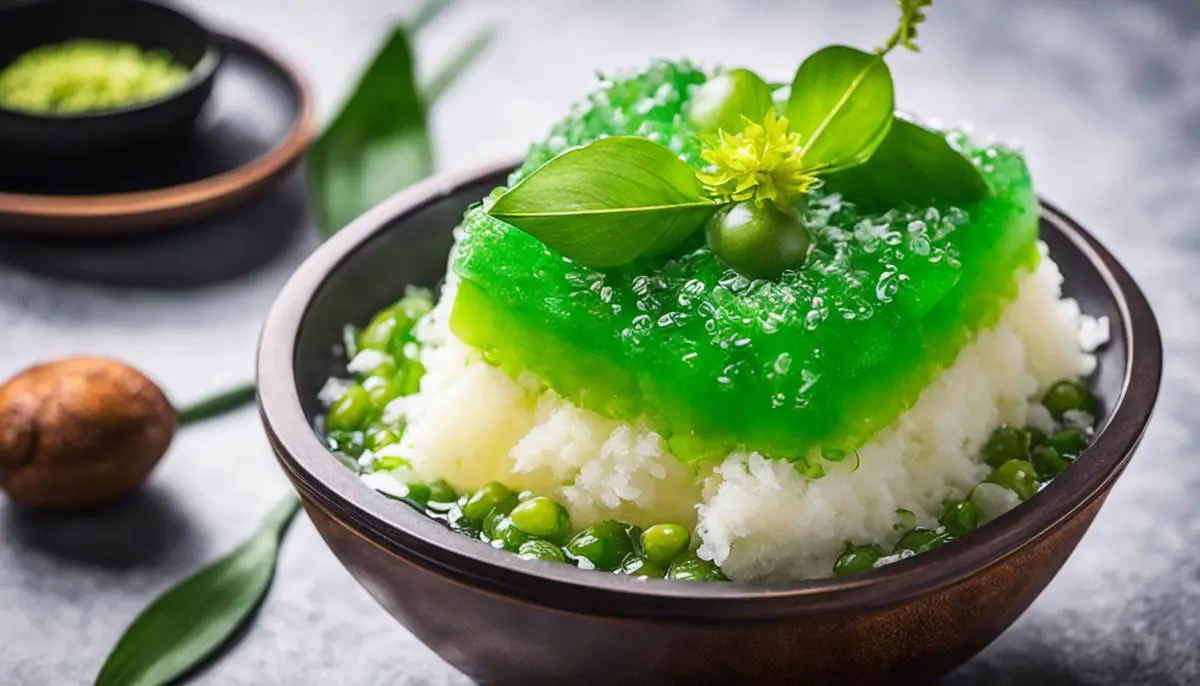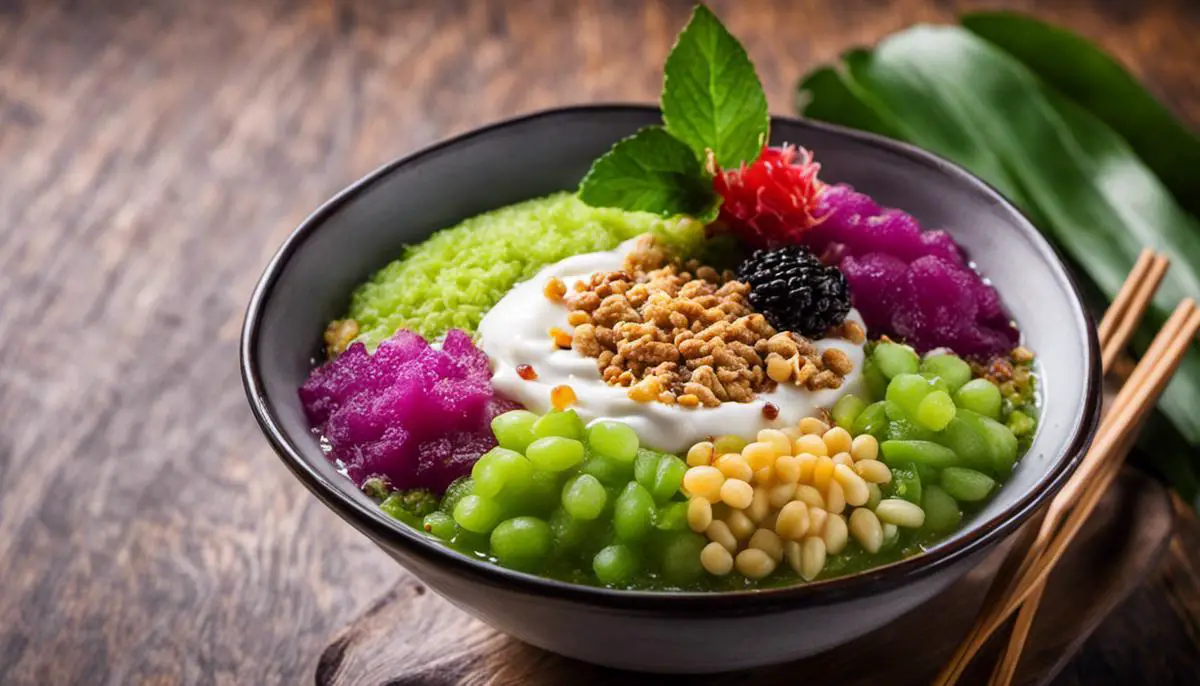
Welcome to the delicious world of Cendol, a beloved dessert that has evolved across cultures and time, enthralling taste buds in every spoonful. A quintessential creation from the culinary traditions of Southeast Asia, Cendol has garnered international attention due to its unique taste and vibrant colors. This discussion will navigate through the intriguing history of Cendol, the masterful blend of ingredients that creates its signature taste, the numerous varieties that adorn the global food scene and the cultural significance this dessert holds in its native regions. Unravel the delicious threads of this dessert’s journey, as it continues to entice the modern palate with its humble yet versatile nature.
History of Cendol
Ah, the beautiful world of food – it’s all about layers and layers of culture, history, and, most importantly, sumptuous flavors. Now, let’s embark on an edible journey to Southeast Asia, where the iconic dessert, Cendol, reigns supreme. Known for its palatable harmony of tastes, textures, and temperatures, it’s no wonder this dessert has transcended borders and earned the love of many food lovers far and wide.
Cendol’s humble beginnings trace back centuries to Indonesia, its widely accepted place of origin. The name itself likely derives from the word “jendol”, which in Javanese and Sundanese languages, translates to “bump” or “bulge,” referencing the dessert’s characteristic worm-like green noodles. Traditionally, these noodles are handmade fresh with rice flour and colored using pandan leaves, rendering an aromatic, vibrant green hue.
The simplicity of its original form is arguably what allowed Cendol to migrate and evolve to what we see today. The primeval form of Cendol was simplicity incarnated: merely the signature noodles served in coconut milk. Over time, as this dessert traveled through the region, it adapted to the tastes and resources of each locale, each evolution only enhancing its popularity and continuing its legacy.
In modern times, Cendol is more of a cold, sweet dessert soup. The green noodles are now nestled in a bed of shaved ice, drizzled with palm sugar syrup, and often accompanied by beloved local ingredients. In Malaysia, red beans, sweet corn, and glutinous rice may join the party, resulting in a glorious fusion of sweet and savory. In Singapore, it’s not uncommon to find Cendol served with a generous dollop of sweetened Durian, while its Vietnamese counterpart, Chè ba màu, features an assortment of additional jellies and beans.
The culinary charm of Cendol lies deeply in its adaptability. It acts as a flavorful canvas of sorts, inviting culinary aficionados to add their own personal touch, from experimenting with sweet versus savory elements to integrating seasonal fruits. This flexibility has certainly aided in diversifying its form and elevating this dessert to legendary status.
Crossing the seas, Cendol has indeed found its way into the ever-experimental western culinary scene. Innovative chefs have transformed this Asian classic into avant-garde variations, from Cendol cheesecakes, ice creams to elegant fusion plated desserts.
Although being reinvented ceaselessly, the humble Cendol never loses its identity or its link to its rich, historical roots. Something magical ensues when those chewy green noodles meld seamlessly with the rich coconut milk, sweet palm syrup, and crunchy ice. It’s a reminder of how food can encapsulate a story, evoking memories of times past and stirring anticipation for what’s yet to come. That right there, my friends, is the real beauty of our beloved Cendol – a timeless sweet treat that effortlessly binds history, culture, and taste buds across the globe. Revel in its goodness and let the bite do all the talking.

Cendol Ingredients and Preparation
Delving deeper into the heart of this whimsical dessert, the list of ingredients that constitute Cendol are relatively simple, and yet are singularly compelling in their aggregation. The foundational components of this Southeast Asian marvel include pandan leaves, mung bean flour, coconut milk, shaved ice, and palm sugar. It may look like an amalgamation of random ingredients, but when combined in the right proportions, the resulting culinary creation is nothing short of spectacular.
Arguably the star of the show, the eponymous Cendol itself, are these vibrant green, worm-like jelly strands. These little tendrils are conjured up from mung bean flour mixed with pandan leaf juice, which lend them their remarkable Chartreuse shade. Aromatic and subtly sweet, pandan leaves infuse the dessert with a unique essence that’s mildly reminiscent of coconut or vanilla.
Another star player in the dish, and the yin to pandan’s yang, is the coconut milk. Rich, creamy and luscious, it envelops the pandan jellies in a velvety embrace, providing an indulgent contrast to the relatively muted cendol strands. This ingredient may vary from the fresh, hand-squeezed variety in Southeast Asia, to the canned or packaged versions elsewhere. Regardless, it cannot be replaced or reduced as it is central to the sweet emulsion that gives Cendol its iconically mellifluous mouthfeel.
Soon follows the sweetness with the introduction of palm sugar, key to Cendol’s addictive allure. By undergoing a slow-cooking process, the palm sugar morphs into a viscous, caramel-like syrup. Drizzled gracefully atop the dish, it pairs delightfully with the creaminess of the coconut milk, forming a match made in dessert heaven.
And lastly, shaved ice, serving as the cooling agent, a soothing salve against the tropical heat, adds another level of fun to the sweet soup creating a delightful dance of textures. All these ingredients come together to create a symphony of tastes that’s as rewarding as it is refreshing.
In the traditional preparation phase, the making of Cendol is no less fascinating. The pandan leaves are first steeped in water and then strained to extract a vibrant, aromatic green juice. This is then incorporated into a mixture of mung bean flour and water that’s carefully poured through a cendol press to produce the distinctive, wormlike tendrils. Once these cool and set, they’re ready to be combined with the rest of the ingredients.
The true beauty of Cendol lies in its simplicity. It demonstrates that exquisite flavors don’t necessarily have to be complicated or convoluted, but can stem from the perfect harmony of basic elements. Whether slurped from a plastic bag from a roadside stall in Singapore, spooned out of a bowl in a high-end restaurant in New York, or shared over laughter in a Kuching kitchen, the charm of Cendol is universal, celebrating the sweet bond that connects us all through food.

Varieties of Cendol
Diving into regional variations of this delightful dessert, Cendol is excitingly diverse across Southeast Asia, each region adding a unique touch.
In Indonesia, Cendol often features jackfruit, a sweet and aromatic fruit that adds not only a rich flavor but a fun texture. A particularly special version that-goers on the island of Java may stumble upon includes durian Cendol. Those who dare to venture beyond the fruit’s notorious aroma are often rewarded with an intensively sweet and creamy addition to their dessert.
Crossing to Malaysia, Cendol frequently goes by its other name, Chendol, and incorporates a delightful assortment of additional toppings. Red beans, glutinous rice, and grass jelly might be found swimming amidst the customary ingredients, adding depth and variety.
Meanwhile, in neighboring Singapore, it can be found that Cendol makes an appearance in a seemingly unusual place: hawkers centers, bustling with food stalls offering local culinary delights. Its version is not fussy, sticking very much to its traditional roots but is equally as relished, giving relief from the sweltering heat of the city-state with its cool, sweet sips.
A hop and a skip away to Vietnam, Cendol appears in the form of Che Ba Mau, or a three-color dessert. Enriched with red azuki beans and jellies, this variation gives a delightful and charming twist to the classic, further demonstrating the endless possibilities of Cendol.
Chefs in cosmopolitan urban settings are also beginning to add their unique spins to this Asian delicacy. An example? New York City’s trendsetting dessert-scene features a Cendol spin-off known as Pandan Cendol Creme Brûlée. Going beyond its conventional form, this creation blends the soft, chewy textures of the traditional Cendol with the creamy, caramelized traits of the classic Creme Brûlée.
On the other side of the globe, in Melbourne, a beverage salute to the desert is shaking up things in the form of Cendol Cocktails. Here, the sweet, creamy, and refreshing aspects of the dessert are reimagined into an enthralling drink that leaves patrons longing for more.
The reinterpretations of Cendol are truly a testament to its enduring legacy and widespread appeal. Each regional variation, the burst of innovation from culinary enthusiasts, the reminiscing over childhood memories, and the gastronomic adventures from foodies keenly exploring new flavors bring us closer as a culinary community. United we stand under the love for food, connecting cultures, traditions, and people, one bowl of Cendol at a time.

Cendol’s Cultural Significance and Popularity
Cendol, despite its humble origins, plays a significant role within the tapestry of Southeast Asian culture. It’s more than just a dessert – it’s an emblem of heritage, a symbol of unity, and an agent of storytelling. Remarkably, it has held onto this status, undeterred by the passage of time or the onslaught of modern influences.
Every slurp of this flavorful dessert reveals the rich history of Southeast Asia – centuries-old trading habits, colonization influences, and the undeniably tight-knit integration of raw resources. It evokes nostalgia—reminding the elderly of their youth, and paints a picture of time gone by for younger generations. It’s a legacy passed down through meticulous hands, effortlessly crossing borders and linking communities.
One cannot overlook the role Cendol has played in fostering entrepreneurship within Southeast Asia either. From roadside hawkers to established dessert cafes, Cendol has proven its worth as both a livelihood and a staple in the business scene. Its wide popularity encourages aspiring business owners to chase their dreams, start-up costs being relatively low and the dessert appealing to a broad customer base.
Cendol isn’t just sold and bought—it’s celebrated. Multiple Southeast Asian countries partake in Cendol themed festivals, enticing locals and tourists alike. Malaysia, for example, hosts an annual Penang International Durian festival where Cendol durian, a popular variant of Cendol, is a top hit. Festivals like these are not just commercial opportunities but also a chance to fuse Cendol into the collective memory, a sweet reminder of shared Asian heritage.
The act of sharing Cendol creates bonds and reinforces communal ties. Cendol gatherings, whether spontaneous roadside stops or planned family outings, evolve into shared experiences—to laugh, to converse, to connect. Sharing this dessert breaks down barriers and cultivates camaraderie. Cendol-associated occasions, be it beating the mid-day heat, or marking a special day, become woven into the societal fabric, contributing to a unified cultural identity.
With its profound cultural roots and wide-reaching popularity, Cendol becomes a cultural ambassador in its own way, introducing the world to Southeast Asia’s unique culinary history and traditions. Its presence on international menus sparks intrigue, drawing in food enthusiasts. The dessert narrates tales of Southeast Asia’s extraordinarily diverse food culture to audiences that may be unaware of this rich gastronomic journey.
While Cendol has evolved and adapted to the demands of the modern palate, it remains a dessert that refuses to forget its origin. It is this deep cultural allegiance and adaptability to change that truly makes Cendol a marvel of culinary tradition and a beloved dish through generations. Through Cendol, Southeast Asia shares a piece of its historic charm and unites people for an unforgettable culinary experience. As you delve into a bowl of Cendol, you’re not merely sampling a dessert, you’re partaking in a delightful dance of history, culture, and flavor. This is the magic of Cendol. A simple dessert, a powerful symbol, and a timeless treasure of Southeast Asia.

Indeed, the story of Cendol is a testament to the power of food as a catalyst for connection, heritage preservation, and love. The way it has intricately woven itself into the fabric of various communities showcases its unifying effect. Its humble origins, combined with the evolving palate of global food lovers, continue to encourage new variations and innovations. So, whether it’s the traditional version or a modern twist that carries the charm, Cendol stands as a delightful representation of the vibrant, diverse, and fluid world of food culture. Its journey, which spans through history, countries, and cultures, tells a timeless tale of shared culinary passion, thereby standing out as a sweet testament to global gastronomy.



